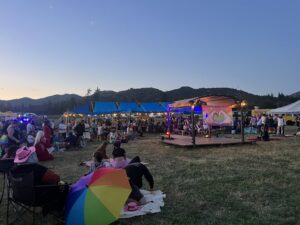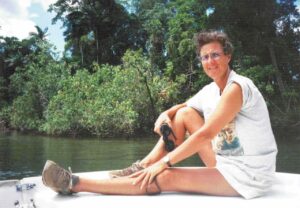Our local Pride Festival was progressive, but visible gay communities in the Applegate are nothing new.

by Christina Ammon
When LongSword Vineyard held a Pride Festival a few weeks ago, I confess I was surprised. An event celebrating people who are lesbian, gay, bisexual, transgender and queer seemed a big city thing—out of the purview of conservative rural areas.
But my friend (and longtime local Applegater) Barbara Summerhawk quickly brought me up to speed. Although she did concede that the Applegate Pride Festival was “a first,” visible gay communities are nothing new to the Applegate Valley.
In fact, during the “Back-to-the-land” movement of the 1970s, many lesbian women moved to the Applegate to form women-only communes. Barbara was part of this—both as a participant and as a researcher.
With a university grant, in 2000 she co-wrote the book Circles of Power: Shifting Dynamics in a Lesbian-centered Community (New Victoria Publishers). The book is mostly centered in the Applegate and is informed by dozens of interviews about how the communities formed and operated. It explores themes of power-sharing, homesteading, and problem-solving these women-only spaces. Authoring the book gives her a broad view of the history (or herstory!) of these communities in the Applegate.
Hoping for a Blank Slate
Barbara first found the Applegate women communities in 1986. She was hitchhiking along what became known as “The Amazon Trail”—a series of lesbian land collectives up and down the I-5 corridor. She recalls arriving at the Applegate’s Womanshare community (now NativeWomanShare) and meeting one of the founders, Carol Osmer, in the group kitchen. Carol directed her down to the pond where all the women were hanging out. “I made my way in the direction …and heard joyous voices, laughter. I dove right in and … felt immediately welcomed.”

LongSword Vineyard’s Pride Festival was held on June 3, 2023. Hundreds turned out to celebrate.
At the time, many lesbians were drawn to rural areas like the Applegate as part of a utopian ideal that women could escape the patriarchal institutions of the city and create their own models of decision-making, farming, and going about life.
“There was a spirit of separatism in the movement,” Barbara reflects. The women hoped they could invent new structures that would reflect an alternative set of values. This approach stood in contrast to other feminist who stayed in urban areas to organize and gain power within the existing institutions.
“When I first came to Oregon …the greater rural women’s community was vibrant and alive with an alternative culture that my old self had once judgmentally dismissed as escapist,” she says. “But by the end of the week, I had stood in ceremonies, worked in the communal garden, cooked dinner, and sat down to eat with dozens of women whose concerns were about women, of women, for women. I felt a certain sense of support and freedom that I hadn’t experienced before.”
Over time, however, Barbara and many of the other women came to realize that the outside world was impossible to avoid. Rural living inevitably depends on interactions and procuring supplies from town—even going to work in town.
“They thought there was a blank slate but there wasn’t,” she explains.
But the collectives did achieve a major goal: Providing a safe space for women who didn’t feel accepted in the larger society.
Seeking Inclusion
My own friendship with Barbara started over a decade ago with a shared love of paragliding. We both launched regularly from Woodrat Mountain and shared the sky over the Applegate Valley. I was always inspired by Barbara’s humor, boldness and zest for life. As women in the sport, we comprised a very small minority—a situation that sometimes felt uncomfortable. But modeled for me the idea that one shouldn’t wait around for inclusion. She’d say, “Include yourself!”

Barbara Summerhawk by the pond near WomanShare (now NativeWomanShare) in 1988. Of her visit, she says, “‘I felt immediately welcomed.” She soon began to build her own cabin on Humbug Creek Road.
When I asked her how inclusion played out for the lesbian communities in the wider Applegate community in the early days, she replied, “The land communities that I know pretty much got along with their neighbors—who all kind of knew what was going on. There was a growing acceptance.” Although some Applegaters were ideologically opposed homosexuality because of religion or personal views, face-to-face interactions were almost always cordial.
“How to interpret that?” she wondered out loud. “It seems to me that the more surface interaction people have, the more a sense of acceptance seems to sink down into the roots of the community.”
The Importance of Race
The issue of inclusion that the communities struggled with back then still persists today, although it’s taking on new themes. Often, it’s within the lesbian communities themselves. There is now a growing awareness of race.
Although the co-author of Circles of Power, La Verne Gaghabib, was able to add her perspective as a woman of color, race still goes profoundly unrepresented and unaddressed. “The women that first came out here were nearly exclusively white,” Barbara says. “There is now more consciousness of people of color and of correcting that imbalance.”
The WomanShare that Barbara was originally part of is now called NativeWomanShare and places more emphasis on people of color, even holding certain events that Barbara, being white, wouldn’t be invited to attend. Barbara understands this and is careful to not label it separatism.
It’s not separatism so much as autonomy,” she explains. “They want to have discussions with people who share their experiences. NativeWomanShare is building in a different direction, and that is good.”
Growing Expression and Acceptance
So, it turns out that a visible gay presence is nothing new in the Applegate after all. Still, it was striking to attend the Pride celebration and see hundreds of people from within and beyond the Applegate dancing, applauding to drag shows, and openly showing affection. Barbara says the event definitely brought the Applegate to the next level of expression and acceptance.

Pride Festival at LongSword Vineyard on June 2, 2023
“Some people weren’t exactly happy about it, but it was there and it was visible,” she says. “In the 70s and 80s, you couldn’t have imaged having that. I loved it!” She thinks the event’s success was a reflection of a larger acceptance in society at large: The majority of Americas now support gay marriage.
For Barbara, a sense of inclusion stretches beyond the boxes of identity to the landscape at large. “I first came to the Applegate in 1967 and when I first swam in the Applegate River, I felt more at home here than any other place in the world.”
Thoughts to share? We’d love to hear from you directly! Please email: [email protected]


